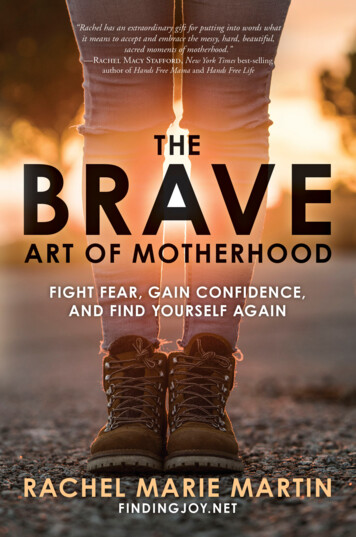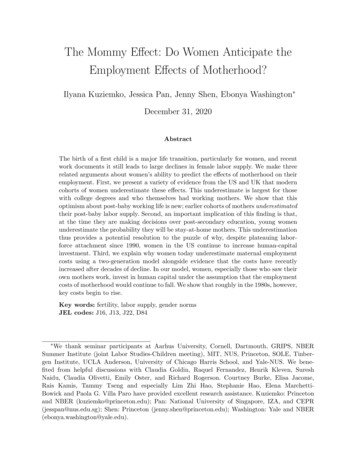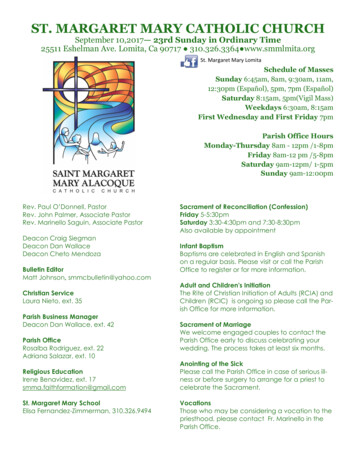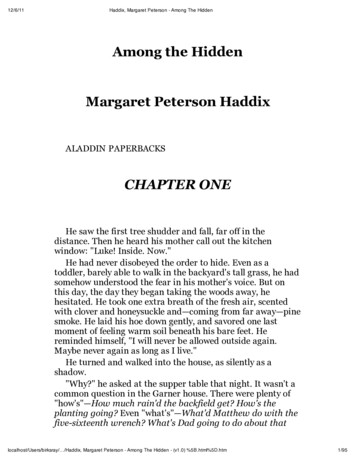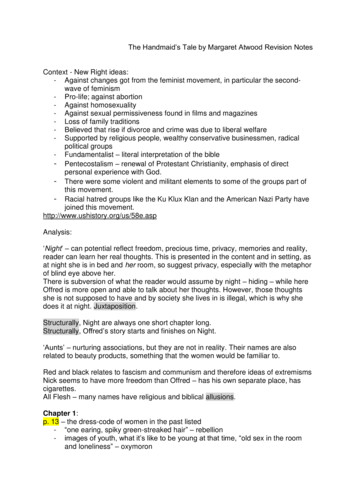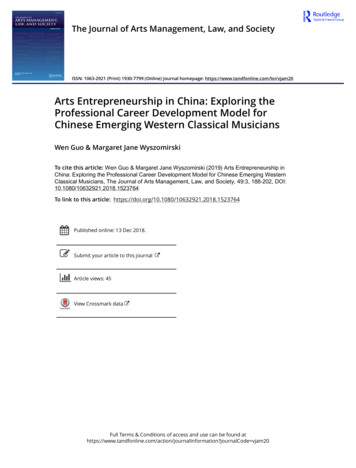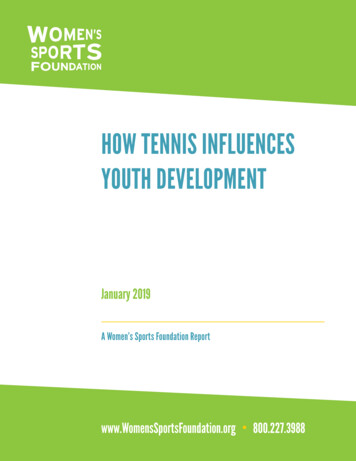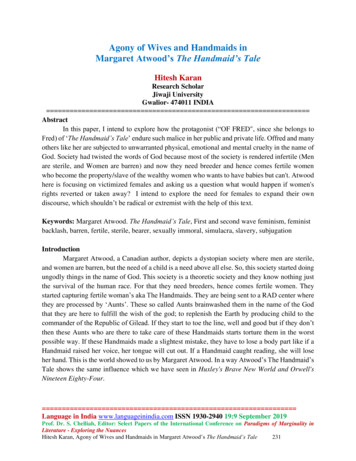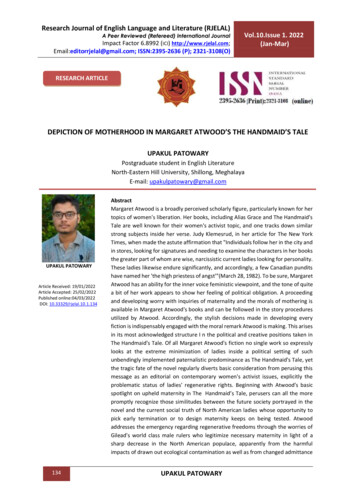
Transcription
Research Journal of English Language and Literature (RJELAL)A Peer Reviewed (Refereed) International JournalImpact Factor 6.8992 (ICI) http://www.rjelal.com;Vol.10.Issue 1. 2022(Jan-Mar)Email:editorrjelal@gmail.com; ISSN:2395-2636 (P); 2321-3108(O)RESEARCH ARTICLEDEPICTION OF MOTHERHOOD IN MARGARET ATWOOD’S THE HANDMAID’S TALEUPAKUL PATOWARYPostgraduate student in English LiteratureNorth-Eastern Hill University, Shillong, MeghalayaE-mail: upakulpatowary@gmail.comUPAKUL PATOWARYArticle Received: 19/01/2022Article Accepted: 25/02/2022Published online:04/03/2022DOI: 10.33329/rjelal.10.1.134134AbstractMargaret Atwood is a broadly perceived scholarly figure, particularly known for hertopics of women's liberation. Her books, including Alias Grace and The Handmaid'sTale are well known for their women's activist topic, and one tracks down similarstrong subjects inside her verse. Judy Klemesrud, in her article for The New YorkTimes, when made the astute affirmation that "Individuals follow her in the city andin stores, looking for signatures and needing to examine the characters in her booksthe greater part of whom are wise, narcissistic current ladies looking for personality.These ladies likewise endure significantly, and accordingly, a few Canadian punditshave named her 'the high priestess of angst'"(March 28, 1982). To be sure, MargaretAtwood has an ability for the inner voice feministic viewpoint, and the tone of quitea bit of her work appears to show her feeling of political obligation. A proceedingand developing worry with inquiries of maternality and the morals of mothering isavailable in Margaret Atwood's books and can be followed in the story proceduresutilized by Atwood. Accordingly, the stylish decisions made in developing everyfiction is indispensably engaged with the moral remark Atwood is making. This arisesin its most acknowledged structure I n the political and creative positions taken inThe Handmaid's Tale. Of all Margaret Atwood's fiction no single work so expresslylooks at the extreme minimization of ladies inside a political setting of suchunbendingly implemented paternalistic predominance as The Handmaid's Tale, yetthe tragic fate of the novel regularly diverts basic consideration from perusing thismessage as an editorial on contemporary women's activist issues, explicitly theproblematic status of ladies' regenerative rights. Beginning with Atwood's basicspotlight on upheld maternity in The Handmaid’s Tale, perusers can all the morepromptly recognize those similitudes between the future society portrayed in thenovel and the current social truth of North American ladies whose opportunity topick early termination or to design maternity keeps on being tested. Atwoodaddresses the emergency regarding regenerative freedoms through the worries ofGilead's world class male rulers who legitimize necessary maternity in light of asharp decrease in the North American populace, apparently from the harmfulimpacts of drawn out ecological contamination as well as from changed admittanceUPAKUL PATOWARY
Research Journal of English Language and Literature (RJELAL)A Peer Reviewed (Refereed) International JournalImpact Factor 6.8992 (ICI) http://www.rjelal.com;Vol.10.Issue 1. 2022(Jan-Mar)Email:editorrjelal@gmail.com; ISSN:2395-2636 (P); 2321-3108(O)to fetus removal. Albeit an assortment of regenerative advances have for some timebeen accessible to the general public addressed in the novel, these developmentshave now been disavowed for an approach of authorized organic maternity withoutresponse to innovative mediation, recommending that a definitive objective ofGilead's male chiefs isn't the increment of populace but instead the social control ofladies. Subsequently, fatherly experts in Gilead react to the affirmed "emergency"of declining birth rates by standardizing substitute maternity to guarantee its maleline of replacements and to deny possibly defiant ladies their previousindependence in choosing whether or not to conceive an offspring.Keywords: Margaret Atwood, The Handmaid's Tale, feminism, oedipal complex,patriarchy, masculinity, motherhood, femininity, dystopia, reproductive rights,religious fundamentalism, female identity, child trafficking, Margaret Thatcher, etc.INTRODUCTIONThe original which acquired Atwood thesituation with abstract symbol is without a doubtThe Handmaid's Tale, distributed in 1985. Onaccount of an effective TV series transformationdelivered in 2017, right now in its fourth season, TheHandmaid's Tale has been partaking in a fantasticrenaissance. Its mass ubiquity has brought about theapportionment of the red outfits of the Handmaids,worn alongside a white winged hat, by femaledissenters worldwide to exhibit the flimsy line thatisolates a few current political states from theRepublic of Gilead (Atwood 2019b). Atwood's semiLatin message Nolite te bastardes carborundorum(Don't allow the mongrels to crush you down) wasobscure to the overall population a couple of yearsprior, however is presently shown on fight pennants.That the novel resounds with such countlessperusers and nonconformists across the globe issomewhat discouraged information, for it vouchesfor the continuous breaks of common liberties andcommodification of lives for the sake of a higherstrict request. The Testaments (2019) re-establishestrust in mankind and the force of sisterhood. Setfifteen years after the end scene of The Handmaid'sTale, The Testaments uncovers the conditions ofGilead's fall. The novel is a scattered first-individualaccount from three characters: Aunt Lydia, whoends up being a covert operative helping out theMayday obstruction and Offred's two girls: AgnesJemima, brought into the world in the pre-Gileadworld and taken from her mom at five, and Nicole,carried as a new-born child out of Gilead to Canada.135Each of the three, firmly coordinated by Aunt Lydia,prevail with regards to pirating proof that uncoveredthe bad idea of driving Commanders and in the endassists with ousting the Gileadean system. In myinvestigation of The Handmaid's Tale I center aroundthe connection among Offred and her mom, whichis illustrative of the more extensive peculiarity of theBacklash. I examine what the mother and her agemeant for the maternal decisions of the nominalHandmaid and talk about the injury of kidevacuation endured by Offred. In the last part of thereview I inspect The Testaments from theperspective of third-wave woman's rights and breakdown the predicament of Offred's girls, zeroing in ontheir mentalities towards womanhood andmaternity.Dissimilar to her mom, who had her at theage of 37, Offred brought forth a little girl at the ageof 25. The principle account is connected by a 33year-old Offred, who has been isolated from hereight-year-old girl for quite a long time and has noinformation on her posterity's whereabouts.Subsequently, the hero's insight of parenthood canbe partitioned into a five-year time of directmothering and a three-year time of kid hardship. Theperuser doesn't discover that Offred is a motheruntil page 49, when the memory of Offred's momprompts the memory of having her little girl stole.The juxtaposition of the memories of her mom withthose of her little girl is not really unplanned andought to be perused as far as intergenerationaltransmission.5 The mother and the girl generally fillin as a lady's twofold - somebody she used to be andUPAKUL PATOWARY
Research Journal of English Language and Literature (RJELAL)A Peer Reviewed (Refereed) International JournalImpact Factor 6.8992 (ICI) http://www.rjelal.com;Vol.10.Issue 1. 2022(Jan-Mar)Email:editorrjelal@gmail.com; ISSN:2395-2636 (P); 2321-3108(O)somebody she may turn into. As Carl Jung takes noteof, "each mother contains her little girl in herself andeach little girl her mom, and . . . each lady broadensin reverse into her mom and advances into her girl"(1980, 188). Nonetheless, in The Handmaid's Taleintergenerational transmission is upset, sinceOffred's girl is appropriated by the frameworksupposedly to her benefit. "She's in great hands,they said. With individuals who are fit. You are illsuited, however you need the best for her. Don'tyou?" (1985, 49). Mindful that any demonstration ofopen disobedience would either prompt her quickdemise or result in delayed passing throughexpulsion to the Colonies, Offred faces nochallenges. Whenever shown the image of her girl,who "resembled a holy messenger, grave, reduced,made of air" (1985, 49), she shouts: "You've killedher" (1985, 49). Henceforth, she emblematicallysanctions the demise of her girl. From this second.the little girl will work more as a phantom like figure,an intrapsychic element rather than a genuineperson.6 "Perhaps I in all actuality do consider heran apparition, the apparition of a dead young lady, ayoung lady who passed on when she was five,"Offred reflects (1985, 74). The repulsiveness of theobscure and the never-ending hardship appear to besupplanted by the injury of kid misfortune andgrieving. The emblematic demise of her girl shouldhelp Offred pre-empt the aggravation that madeDemeter crazy on the grounds that having a girlkidnapped definitely breaks the mother's reality.Offred can't release herself distraught with stress,not to mention rage, since mental stability is themain part of her life she can hold from her preGilead past: "Mental stability is an importantbelonging; I crowd it the manner in which individualsonce accumulated cash. I save it, so I will haveenough, when the opportunity arrives" (1985, 119).To endure the barbarities incurred by the Gileadeansystem, Offred should neglect the memory of herlittle girl, yet the stifled will in general return.However at first the hero might appear to besincerely isolates from her girl, this saved mentalityis a safeguard component, and doesn't add up to theshortfall of maternal love. The smotheredrecollections of her little girl more than once trackdown their approach to Offred's cognizant brain, to136be subdued once again. In the location of breadproduction, which helps Offred to remember herown mothering, the smell of yeast represents adanger to the hero's faked uprightness. Itaccidentally summons her old Self, whose vital partwas parenthood: "It scents of me, in previous times,when I was a mother. This is a slippery smell, and Irealize I should close it out" (1985, 57). AssumingOffred is to get by, she should neglect her maternaljob, both past and imminent. Regardless of whethershe bears a youngster, she won't ever be permittedto mother it, for, as a Handmaid, she is diminishedto an exclusively conceptive capacity. Mistreated inview of her natural maternal potential, incidentally,she won't ever be permitted to satisfy it on anenthusiastic level. As an ill-suited, fallen lady, aHandmaid doesn't have the right to mother any kid:"She'll be permitted to nurture the child, for a coupleof months, they put stock in mother's milk. Afterthat she'll be moved, to check whether she canrehash it, with another person who needs a turn.However, she won't ever be shipped off theColonies, she won't ever be announced Unwoman.That is her award" (1985, 137). In the Republic ofGilead, just ethically upstanding ladies are concededthe honor of mothering. Regardless of Offred'swilled constraint, her little girl returns to her indreams, of which the most terrible is that of theircatch and division. The fantasy she fears the most isto a lesser degree a fantasy in Freud's terms than areal memory of their endeavored getaway toCanada. At the beginning it is a powerful depictionof the fierce pursue, during which Offred is"running," "pulling" and "hauling" (1985, 84) her girlalong until she starts to cry. The dread of potentialcatch is serious to such an extent that, dreading fortheir life, Offred "furiously" (1985, 85) quiets herlittle girl. Shots are discharged close by, and thescene transformations into a sluggish movieoverflowing with delicacy. Offred pulls her little girldown and protects her with her body. Sadly, they arefound, caught and isolated. The vicious idea of theircapture is out of the blue offset Offred's portrayal ofa red pre-winter leaf, and trees turning uncoveredearly. Such an incongruent juxtaposition shows thatto adapt to the awful experience of the passing of alittle girl, Offred accidentally falls back onUPAKUL PATOWARY
Research Journal of English Language and Literature (RJELAL)A Peer Reviewed (Refereed) International JournalImpact Factor 6.8992 (ICI) http://www.rjelal.com;Vol.10.Issue 1. 2022(Jan-Mar)Email:editorrjelal@gmail.com; ISSN:2395-2636 (P); 2321-3108(O)separation. She separates herself from thefrightening experience (or its memory) to numb thetorment. Separation is a guard instrument thathappens outside the individual's cognizant psycheand in its outrageous structure brings aboutamnesia. Offred, be that as it may, can't allowherself to fail to remember her girl, the mostvaluable individual in her life. Whenever she saysabout the leaf that "[i]t's the most lovely thing I've atany point seen" (1985, 85), it is apparent that sheisn't contemplating herbal subtleties at such anawful second. To endure the unbelievable, the heroredirects her consideration from her girl, who clearlyis "the most lovely thing" she has at any point seen,and extends it onto the leaf. On account of thisinstrument, she endures the detachment injury andholds the memory of the last experience with hergirl. The value she should pay for removing herselffrom the memory of misfortune is the ensuingseparation from her body and self-destructiveideation. "I feel quiet and drifting, as though I'm asof now not in my body" (1985, 85), says Offred,recalling the second both of them lay sequesteredfrom everything. Of the multitude of feelings,serenity is definitely not a characteristic response tothe danger of being gotten; thus, smothered furyand dread will before long actuate Offred'sdownturn. The unnatural self-control and selfdestructive considerations will go with the heronearly to the furthest limit of the story, when sherecaptures her body and stirs her stifled faculties. Itis difficult to decide if Offred experienced separationduring the catch, or maybe, and almost certain,established it a short time later. The headliners inthe clever occur three years after their capture, yetthe memory of her girl "holding out her arms to[her], being out of hand" (1985, 85) holds a solidgrasp at the forefront of Offred's thoughts. The freshinsight about her girl, conveyed to her secretly as aPolaroid picture, opens injuries from way back.However from one viewpoint she celebrates that herlittle girl is well, on the other, she observes the photooverpowering. The agonizing acknowledgment thatshe has been killed from her girl's life and deletedfrom her memory makes her need to end her ownlife. The recently incurred enduring is to such an137extent that she wishes she had never been giventhat photo.The anxiety that her girl doesn't recall heradds up to Offred's emblematic passing. Forgottenby her girl, she no longer takes part in theintergenerational transmission even in the mannerin which dead moms do. While her own mom goesabout as a substance inside Offred's mind, shepersonally is missing from her girl's mind and life. Itisn't until late in The Testaments that Offred isbrought together with both her girls outside Gilead."She looked tragic and blissful, both immediately"(2019, 399), notices Nicole upon their experience.The eighteen-and fifteen-drawn out partitions fromher girls more likely than not negatively affectedOffred's life. In spite of the fact that she realized thather posterity were protected, she actually morelikely than not endured the fallouts of youngsterexpulsion. The blissful consummation is in thismanner seriously touched with misfortune andlament on Offred's part.While 10 years and a half isolates Offred'saccount from that of her little girls, the time passbetween the distribution of The Handmaid's Taleand its continuation is 34 years and includes hugechanges in the ladies' freedom development. In1985, postfeminism was acquiring strength; theworld beginning around 2019 has effectively seenthe change of 1990s third-wave woman's rights intoits fourth wave (Chamberlain 2017; Rivers 2017).Albeit The Testaments might be seen as a reactionto the worldwide emergency in equivalenttreatment of genders that combined the rise offourth-wave woman's rights, it is hard to peruse thecontinuation's characters as illustrative of thisdevelopment, since the development dependsvigorously on mainstream society, present dayinnovation and web-based media (Rivers 2017, 5).Along these lines, I welcome the perusing of TheTestaments in a rationalization relationship to TheHandmaid's Tale and, subsequently, as an artisticacknowledgment of the third-wave plan of varietyand strengthening. The change in portrayal from thesingle voice of Offred into three equal first-individualaccounts - Aunt Lydia, Agnes Jemima andNicole/Jade - answers the third-wave women'sactivists' inclination to challenge the essentialistUPAKUL PATOWARY
Research Journal of English Language and Literature (RJELAL)A Peer Reviewed (Refereed) International JournalImpact Factor 6.8992 (ICI) http://www.rjelal.com;Vol.10.Issue 1. 2022(Jan-Mar)Email:editorrjelal@gmail.com; ISSN:2395-2636 (P); 2321-3108(O)comprehension of womanhood. As Dicker andPiepmeier contend, "the third wave works from thesuspicion that character is complex and layered.Since no solid variant of 'lady' exists, we can neveragain talk with certainty of 'ladies' issues'; rather wewant to consider that such issues are just about asdifferent as the numerous ladies who possess ourplanet" (2003, 10). Since the clever comprises of theblended declarations of three unique ladies, theiraccounts vary altogether as far as life experience,language and story strategies, copying effectivelythe manner in which these characters see theencompassing scene, and growing the meaning offemale experience and womanhood. Regardless ofrunning on various tracks, all are women's activiststories that manifest the intricacy of women'sactivist arousing and activism. In this regard, theyreverberation Budgeon's perception about thirdwave particularity: "the beneficial outcome ofopening out definitional limits apparently is anexpanded mindfulness and acknowledgment of thediffuse spaces inside which women's activistcharacters are currently being drilled. It is contendedthat there are various manners by which one mightbe a women's activist and that nobody 'right'method of is being one" (2011b, 282). To embody,Aunt Lydia sets out to utilize the power she hasacquired through coordinated effort with theGileadean system to topple it, in this mannersituating herself immovably on the ladies' side - tothe shock of The Handmaid's Tale's perusers. AgnesJemima structures her women's activist personalityfirst through the dismissal of a Wife job, then, at thatpoint, by figuring out how to peruse and accordinglyconcentrating on books kept distant of Gileadeanladies with the exception of Aunts. Hers, then, atthat point, is the excursion through information.Nicole/Jade, then again, is now a mindful women'sactivist toward the start of The Testaments. Havingexperienced childhood in semi contemporaryCanada, she is a self-enabled teen who, on accountof her new parents and the school she joined in,realizes she ought to continuously "face bad form"(2019, 52). She comprehends that the individual ispolitical, and effectively takes an interest inconventions against Gilead as well as ecologicalfights that reverberation current youth environment138strikes. The most amazing and bewildering part ofThe Testaments, nonetheless, is the intenserefashioning of the personality of wretched AuntLydia from The Handmaid's Tale and projecting herin the job of Gilead's enemy. Through the recoveryof this person - which brings up a large number ofmoral issues inborn in an account of compulsorycooperation - Atwood highlights the requirement forladies' fortitude, the thought that was determinedlytended to and tracked down ailing in the existencesof her characters up to the distribution of theMaddaddam set of three. The disclosure of thesculpture committed to Becka, Agnes Jemima'sdearest companion, who forfeited her life so Agnesand Nicole could get away from Ardua Hall anduncover the bad substance of Gilead, is anunambiguous accolade for ladies' fortitude thatappears to broaden the made up world. Theengraving, "this remembrance was raised by hersisters" (2019, 415) and "in acknowledgment of thepriceless administrations given by A.L.," that is AuntLydia, is an obvious attestation of the worth ofsisterhood, so much asked continuously wave.7 It isfundamental again to draw a differentiationbetween women's activist fortitude and thepostfeminist sweetheart culture that rose toconspicuousness after the turn of the century and istypified by the American TV series Sex and the City.In her Girlfriends and Postfeminist Sisterhood, AlisonWinch contends that "sweetheart culture rotatesaround homosocial types of control where ladiessecurity through the assemblages of differentladies"; the subsequent companionships aredeceptive for being "showcased as fortitude" and"advanced as qualification and strength" (2013, 5).In a postfeminist model of sisterhood, ladies supporttheir painstakingly chosen companions in a typicalbattle to achieve the ladylike ideal, overwhelminglycomprehended as an attractive meager body.8 Thesisterhood Atwood appears to embrace gets fromsecond-wave woman's rights yet is educated bythird-wave investigate regarding the term as "in ageneral sense defective, in light of the fact that itrose up out of ladies liberationists who didn'trecognize the degree to which ladies persecutedifferent ladies" (Evans 2015, 112). The personalityof Aunt Lydia further confounds this definition, sinceUPAKUL PATOWARY
Research Journal of English Language and Literature (RJELAL)A Peer Reviewed (Refereed) International JournalImpact Factor 6.8992 (ICI) http://www.rjelal.com;Vol.10.Issue 1. 2022(Jan-Mar)Email:editorrjelal@gmail.com; ISSN:2395-2636 (P); 2321-3108(O)she "is glad to obliterate ladies who have disguisedthe upsides of the male centric system" (Enright2019). The original's sisterhood, then, at that point,is not generally founded on orientation similarityhowever on women's activist subjectivity and"stresses the shared characteristic among andbetween an enormous and various gathering ofactivists focused on destroying sexism" (Evans 2015,113). Strangely, the antiquated outfit of the PearlGirl in which etched Becka is clad is suggestive ofsuffragettes, whose objectives were the option tocast a ballot and own property as well as admittanceto instruction. Those principal gains achieved by theprimary wave were the main freedoms to be deniedto ladies by the Republic of Gilead, relapsing societyto the nineteenth century. The cross-over of theseapparently unique women's activist waves in therealm of Gilead powerfully catches thecontemporary world, in which nations that haveseen the rise of fourth-wave women's liberation aremaking a hazardously retrogressive stride towardscontroling ladies' independence, while in certainsocial orders, requesting admittance to training is asyet an extreme women's activist position.9 Presentday women's activist fortitude, in this way, shouldtake into consideration the majority of feminismsand perceive that it is "a dynamic and responsivephilosophy that endeavors to oppose essentialismand universalizing, to adjust to ladies' consistentlychanging encounters and a ceaselessly movingpolitical scene" (Rivers 2017, 3) and whose "pointisn't to foster a woman's rights which makesauthentic cases for the benefit of ladies however topropel a legislative issues in view of self-definitionand the requirement for ladies to characterize theirown relationship to woman's rights in manners thatsound good to them as people" (Budgeon 2011b,273). This intricacy of female experience is exhibitedthrough the biographies of Offred's little girls; for avery long time their accounts separate TheHandmaid's Tale from its continuation, creatingalong two unique ways. Agnes Jemima experienceschildhood in the Republic of Gilead as aCommander's girl, though child Nicole is raised inCanada by a couple having a place with anobstruction development. In the primary plotline ofThe Testaments, they are 23 and sixteen years of139age, individually. The personality of Nicole,pseudonym Jade, takes after Atwood's characters,for example, Sabrina Chase from The Blind Assassinor Anne Marie from Hag-seed, who embody arenewed person around who isn't in bondage tocustomary orientation jobs. They know what theyneed and are adequately certain to accomplish itagainst individuals' assumptions, not to mentionendorsement. Contrasted and Atwood's preMaddAddam female characters, they address expecta superior future. All things considered, the fall ofGilead would not have happened yet forNicole/Jade, whose secret name implies a valuablegreen stone, connoting trust, "virtue and quietness"as well as "astuteness accumulated in serenity." Jade"coordinates the psyche with the body," "advancesindependence" and "urges you to become who youtruly are" (Hall 2003, 152). Subsequently, Atwoodsupplies her most youthful female person in thenovel with a charm to help her characterdevelopment as per her body however in her ownspecific manner. Nicole realizes that her life systemsdoesn't decide her fate, and accordingly at sixteenyears old, not at all like her sister who experiencedchildhood in Gilead, she has not really thought aboutplanned wifehood or parenthood. As opposed toNicole, Agnes Jemima is compelled to think aboutand get ready for wifehood and ensuing parenthoodfrom her initial years. Her marriage is organizedwhen she turns thirteen, which is viewed as the idealage to deliver a compliant spouse: "Thirteen isn'texcessively youthful. Everything depends," says oneof the Aunts, "It does contemplates whether we cantrack down a legitimate match. They settle directlydown" (2019, 154). Dissimilar to a portion of hercompanions, who anticipate setting wedded up toascend on the planet, Agnes and her dearestcompanion Becka dread the actual parts of conjugalsex and the deficiency of self in a conjugalassociation. The previous admits: "my response hadbeen more similar to nauseate and hating, andpresently appeared to me inconsequentialconsidering Becka's certifiable ghastliness. She trulyaccepted that marriage would destroy her. Shewould be squashed, she would be invalidated, shewould be dissolved like snow until her" (2019, 163was basically gone). This bleak perspective on theUPAKUL PATOWARY
Research Journal of English Language and Literature (RJELAL)A Peer Reviewed (Refereed) International JournalImpact Factor 6.8992 (ICI) http://www.rjelal.com;Vol.10.Issue 1. 2022(Jan-Mar)Email:editorrjelal@gmail.com; ISSN:2395-2636 (P); 2321-3108(O)spouse's job and destiny, which remains contrary tothe formally celebrated Wife status spread by theterritory of Gilead, clearly comes from the holeamong promulgation and reality. Both Agnes andBecka perceive that spouses are not free either, andshould spurn themselves to satisfy their jobsfaithfully. Consolidating the Bluebeard disorder intoher most recent novel, epitomized by CommanderJudd, whose "Spouses have a propensity for kickingthe bucket" and who "is an extraordinary devotee tothe supportive powers of young ladies" (2019, 63),Atwood repeats her long-standing admonitionagainst "cultural acknowledgment of ladies' casualtyjob" and "the reality of sexual connections asdestinations of conflict and, all around veryfrequently, of real female feelings of trepidation"(Barzilai 2005, 251-52). In Gilead the pervasivenessof chauvinist savagery that incorporates all ladies nomatter what their status is foregrounded by thelewd behavior both Agnes and Becka experiencefrom the dad of the last option. The seriousness ofsexual maltreatment drives Becka towards selfdestruction once she learns she is to be offeredsoon; the vision of marriage and sex obliterates her.Fortunately, she is safeguarded and, gratitude toAunt Lydia, allowed an opportunity to turn out to beimportant for the Ardua Hall people group.Additionally, Agnes, who is chosen for become thenew spouse of Commander Judd, is saved thedestiny of her ancestors by dismissing marriagethrough and through and professing to have a strictcalling. Subsequently, the two young ladies freethemselves from their gendered jobs of imminentWives by choosing the way of an informed, singleAunt. Their decision of information, angry ofpostfeminist philosophy of family life, is the initialmove towards their women's activist subjectivityand gives a false representation of Aunt Lydia'sdeclaration from The Handmaid's Tale that "For theones who come after you, it will be morestraightforward. They will acknowledge theirobligations with willing hearts" (1985, 127). Despitethe solid presence of Offred in The Testaments,albeit dependent on the peruser's capacity to joinstory strands, her viewpoint in the continuation isdecimated. It is plainly presently not The Handmaid'sTale. The peruser never discovers the passionate140expense of detachment from her little girls.Unfortunately, Offred was on the whole correct tostress that her more established little girl would failto remember her and she would sink into obscurity,for "extremely small kids might not be able to reviewunfriendly occasions that happened during theirearliest years, not on the grounds that theexperience was awful to such an extent that it hasbeen shut out from mindfulness but since close tonothing is recollected from these years at any rate,because of youth amnesia" (McNally 2005, 820).Agnes Jemima grows up "adored and valued" (2019,9) by her mom Tabitha, the Wife of CommanderKyle. Regardless of whether out of dread that the kidmay ultimately review the savage partition from herorganic
The Handmaid's Tale, distributed in 1985. On account of an effective TV series transformation delivered in 2017, right now in its fourth season, The Handmaid's Tale has been partaking in a fantastic renaissance. Its mass ubiquity has brought about the apportionment of the red outfits of the Handmaids,
